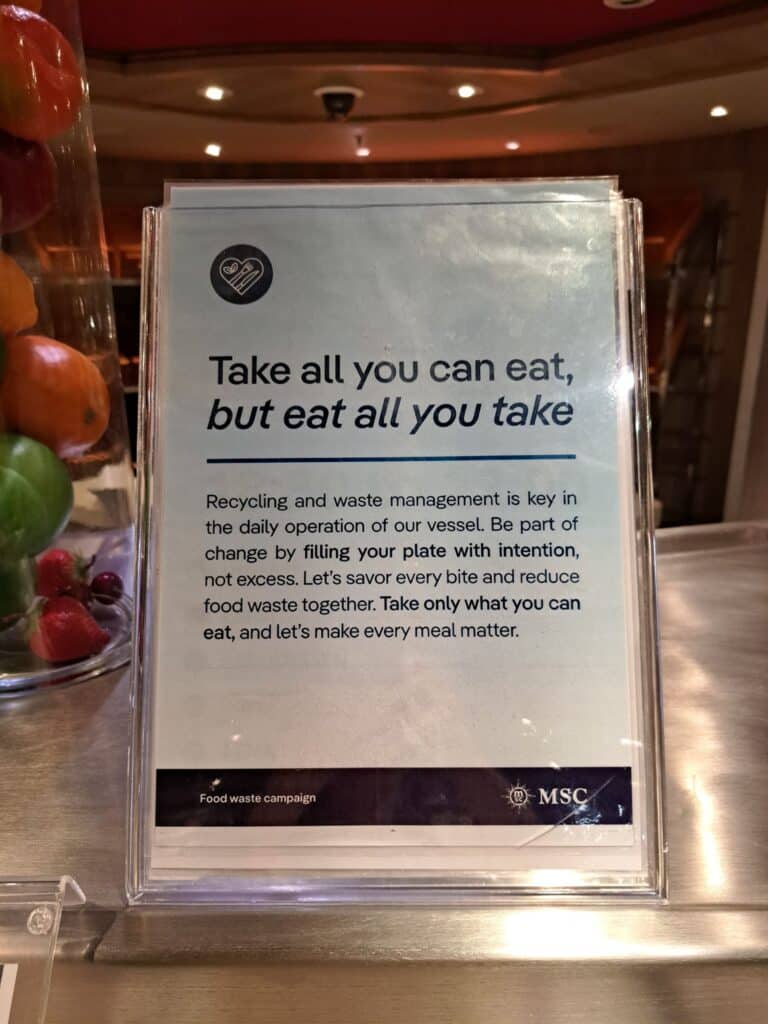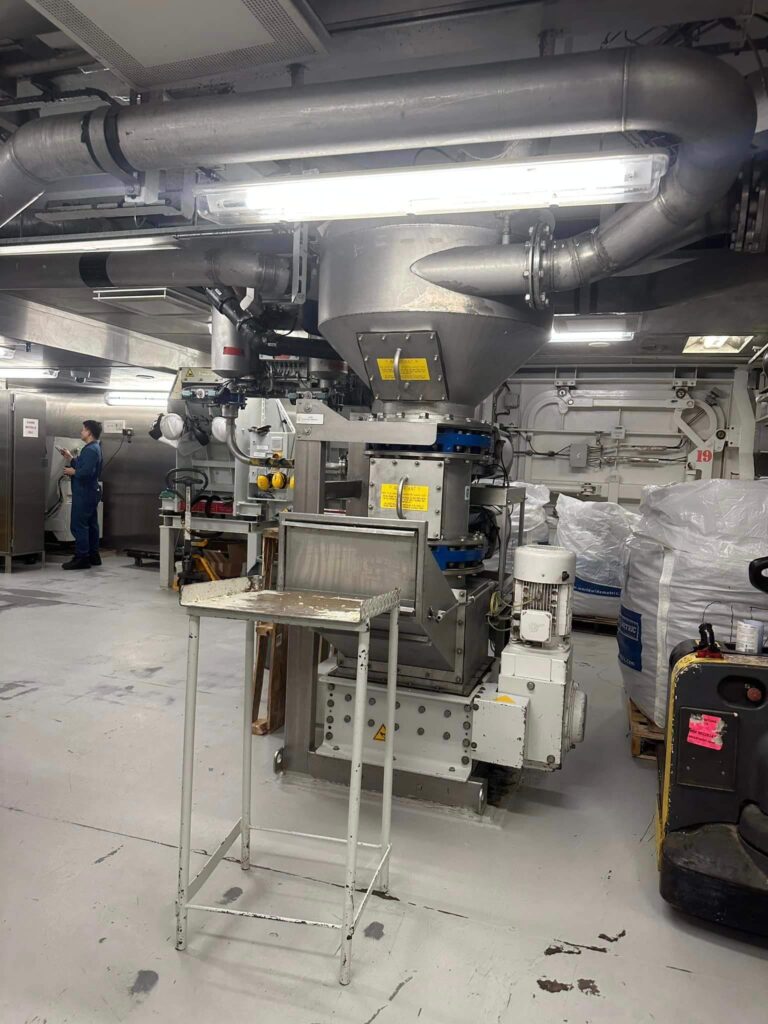Let me tell you the truth, one of the things I like most about cruises is the food.
You can try many different types of cuisine every day, try different restaurants, and of course, taste different dishes at the buffet.
But there’s something that always ruins the moment for me. Walking past tables where people have left behind most of what they took—plates stacked with completely untouched food.
What on earth do cruise ships do with all that uneaten food? Do crew members feast on the buffet remains? Do they toss it overboard for fish? Incinerate it? Donate it?
The truth is that there’s a fascinating mix of strategies, high-tech solutions, and strict regulations – all geared toward minimizing waste and protecting both people and planet.
In this article, we’ll take a look behind the scenes, and I’ll explain to you how cruise lines handle leftover food.
Plenty of Leftovers
Cruise ships are synonymous with abundant food, and it’s all designed to delight guests – but it also means inevitably there will be leftover food.
Perhaps you load up a plate with more than you can eat, or the kitchen prepares extra portions to ensure nobody sees an empty tray.
What becomes of those mountains of uneaten waffles, pasta, and beef at the end of the day?
First, let’s dispel a common misconception. Some imagine that untouched buffet food simply gets sent “below decks” for the crew to eat.
In reality, that’s just a myth. Health and safety rules won’t allow yesterday’s buffet bacon or that tray of sushi rolls to be repurposed directly for crew meals.
Food that has been set out for guests must be discarded after a certain time for hygiene reasons.
In fact, all unconsumed items at the buffet are thrown away. Cruise lines prioritize passenger (and crew) health, so once food has been sitting out or served, it can’t be saved for later.
So does it all just go to waste? Not if the cruise lines can help it. Modern cruise ships are surprisingly sophisticated in managing food to minimize how much gets left over in the first place.
Before we talk about how scraps are disposed of, let’s look at how cruises try to avoid creating so much waste to begin with.
Sophisticated Food Management

One of the best ways to handle leftover food is to prevent having leftovers at all.
Cruise lines have turned reducing food waste into a science. Long before a single steak is seared or pastry is baked, ships are analyzing data and planning menus to right-size the amount of food prepared.
Modern cruise lines use advanced tools – even artificial intelligence to predict how much guests will eat each day. For example, Royal Caribbean Group developed a platform that monitors food supply and uses AI to accurately estimate how many meals to prep and ingredients to order.
The system can adjust food production in real time based on passenger demand, so the ship’s kitchens don’t overcook dishes that won’t be eaten.
For example, if the data and AI foresee that fewer people than usual are hitting the pizza station, the chefs can scale back accordingly.
This initiative, along with better inventory control, helped Royal Caribbean cut food waste by 24% simply by preventing over-preparation.
In addition, cruise lines are trying to serve portions that satisfy guests without leaving piles of scraps on the plate.
Carnival Corporation (which operates Carnival Cruise Line, Princess Cruises, Holland America, Costa Cruises, and others) calls this getting to “just right” portions.
The idea is to serve reasonable portion sizes that guests can finish, while always allowing anyone with a hearty appetite to grab seconds.
Please have a look at the 10 Things You Must Never Do at the Buffet on a Cruise.
Untouched vs. Half-Eaten: What’s Safe to Save?
Not all leftovers are equal. We need to distinguish between unserved food and plate waste (partially eaten food). The fate of leftover lasagna sitting in a warming tray at the buffet’s end is very different from the lasagna you personally half-consumed and left on your plate.
Prepared but unserved food was historically discarded for safety. But in recent years, some cruise lines have pioneered ways to donate these untouched portions to people in need, instead of trashing them.
Costa Cruises was a trailblazer here. In 2017, Costa worked with Italian authorities and food banks to create a first-of-its-kind program.
Surplus restaurant-quality dishes (still perfectly good and never touched by a guest) were delivered to local charities like the Red Cross, who distribute the food to about 100 families in need for every port stop.
Overcoming restrictive laws and health regulations took effort, but Carnival Corporation is working to replicate this model across its other cruise brands globally.
What about partially eaten food? Unfortunately, once food has been touched or partially consumed by a guest, it cannot be repurposed or donated.
Health and safety protocols are strict: that leftover portion of steak must be treated as waste.
So, plate waste goes straight into the ship’s garbage processing system. The key is to manage this waste in the most sanitary and sustainable way possible.
The same goes for any food that sat out on a buffet too long. Even if no guest touched it, once it’s past the safe time window, it’s considered “spent” and gets discarded for safety.
You Can’t Just Throw It Overboard

One thing to understand is that cruise ships operate under very strict environmental regulations.
They can’t deal with food waste (or any waste) however they please – there are international laws and local rules at ports that govern every step. Dumping food overboard indiscriminately is not allowed.
There are exceptions that allow disposal of certain food waste at sea, but only under tightly controlled conditions (like being a specified distance from land and ensuring the waste is ground up). C
Cruise lines must abide by these rules to avoid hefty fines and, more importantly, to prevent environmental harm.
In practice, this means no food waste goes overboard unless the ship is far out in open waters and the waste has been properly processed to be safe for marine environments.
I already explained this to you in the article where we looked at whether waste from toilets is discharged into the sea.
Generally, if a ship is going to discharge food waste into the ocean, it must be at least 12 nautical miles from the nearest land, and the food must be ground into small pieces.
This ensures that the waste disperses and biodegrades quickly without floating in chunks or washing up on beaches.
Many cruise lines take it even further: they won’t discharge anything unless they’re even farther out or unless it’s been through advanced treatment.
Nothing is ever dumped in port or near sensitive coastal areas. In port, all waste is kept on board (in special storage or processing facilities) until it can be offloaded to licensed garbage handlers.